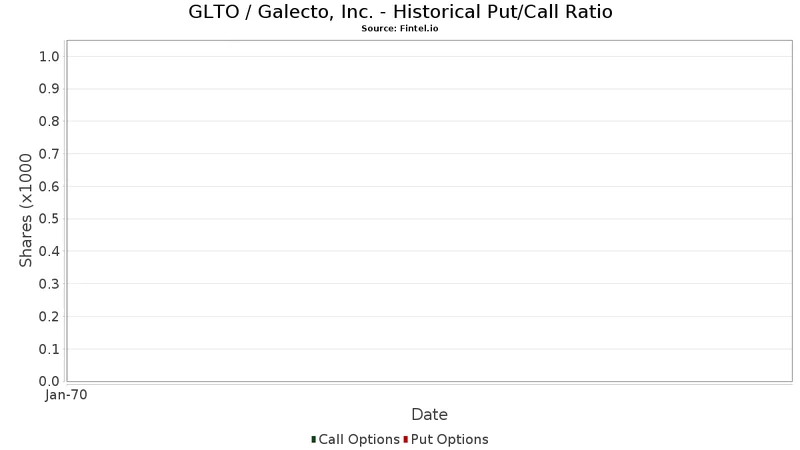On the morning of October 7th, an extraordinary event occurred in the micro-cap biotech sector. Galecto, Inc. (GLTO), a company with a market capitalization of less than $5 million the previous day, saw its stock price ignite. Before the market even opened, shares had surged over 600%—to be more precise, 632% at its pre-market peak.
You can almost picture the flicker of thousands of trading screens, all painting the same impossible, vertical green line. This wasn't a gradual climb; it was a detonation. The volume was equally absurd. Over 42 million shares changed hands before 9:30 AM ET, a figure that demands scrutiny when you consider the company's three-month daily average was a paltry 2.13 million.
The immediate question from any rational observer is: what was the catalyst? An FDA approval? A surprise buyout offer? A revolutionary clinical trial result? The answer, despite many asking Why Is Galecto Stock (GLTO) Up 575% Today?, was a deafening silence. There were no new press releases, no SEC filings, no fundamental change to the business whatsoever. The surge materialized from nothing, a ghost in the machine that briefly made a forgotten penny stock the most talked-about ticker on Wall Street. This wasn't an investment story; it was a mathematical one. And the numbers tell a very different story than the stock chart.
The Mechanics of a Vacuum
To understand what happened with Galecto, you have to ignore the company and look at the market structure. The event was not driven by fundamentals, but by physics—the physics of a low-float stock. Galecto has a public float of only 1.23 million shares (an unusually small number for a NASDAQ-listed company). This is the total number of shares available for public trading.
Now, consider the volume: 42 million shares traded pre-market. This means the entire float of the company changed hands approximately 34 times over. This isn't investing. It's high-speed musical chairs.
Think of a company’s stock float like a room. A large-cap stock like Apple is a vast concert hall; it takes an enormous amount of buying pressure to move the air inside. A micro-cap like Galecto, however, is a small, airtight pressure chamber. In this environment, even a modest injection of buying interest—perhaps from a handful of momentum algorithms or a small group of coordinated traders—acts like a sudden influx of gas. The pressure (the stock price) doesn't just rise; it explodes. The lack of available shares for sale creates a vacuum that sucks the price upward at a violent velocity.

We can quantify the sentiment shift that followed this mechanical move. Data from Stocktwits shows message volume exploding from "extremely low" to "extremely high" and sentiment flipping from bearish to "extremely bullish" within 24 hours. But this is a classic case of correlation, not causation. The chatter didn't cause the surge; the surge, a purely technical event, caused the chatter. Retail traders weren't reacting to good news about Galecto's cancer pipeline; they were reacting to a green line on a chart. The question this raises is deeply unsettling: if a stock's value can be multiplied by seven based on structural mechanics alone, what does its price truly represent?
A Fundamental Disconnect
Once the noise of the trading frenzy subsides, we are left with the quiet, sobering reality of Galecto's balance sheet. I've analyzed hundreds of filings for small-cap biotechs, and the gap between this company's financial state and its sudden market valuation is one of the most extreme I've seen.
Galecto is a clinical-stage company with no revenue. It posted a net loss of $21.4 million in 2024. As of the second quarter of 2025, it had just $10.2 million in cash and cash equivalents remaining. Management’s own forecast states this cash is only sufficient to fund operations "into 2026." They have explicitly warned that "substantial additional capital" will be required to fund future operations, including the clinical development of their most promising drug candidates.
The pipeline itself, while scientifically interesting, is in its infancy. The company's new focus is on GB3226, a potential treatment for Acute Myeloid Leukemia. The next major milestone is an Investigational New Drug (IND) application to the FDA, which they plan to submit in the first quarter of 2026. This is a critical, but very early, step. An IND filing is simply permission to begin human trials. It is years and hundreds of millions of dollars away from a marketable product, with a statistically high probability of failure along the way.
It’s no surprise, then, that expert systems designed to filter out market noise are uniformly unimpressed. TipRanks' AI analyst, Spark, rates GLTO as an "Underperform," citing the "significant financial challenges, with no revenue, ongoing losses, and high cash burn." Independent ratings agency Weiss Ratings concurs, assigning the company a low "E+" grade, which translates to a "Sell." These are not opinions; they are conclusions drawn from the hard data of the company's precarious financial health. The 632% surge was not a re-evaluation of Galecto's long-term prospects. It was a statistical artifact.
An Anomaly with a Predictable Outcome
Let's be perfectly clear. The Galecto event was not an investment, nor was it a vote of confidence in the company's science. It was a temporary dislocation driven by a specific set of variables: a micro-float, a sudden spike in algorithmic and retail volume, and a complete absence of fundamental news to anchor the price to reality. The surge is not a signal of future success; if anything, it’s a distress flare. It highlights a company whose market structure makes it vulnerable to the whims of speculative momentum, not a sober assessment of its potential to cure disease. The laws of financial gravity are patient. For prices untethered from value, they are also inevitable.
